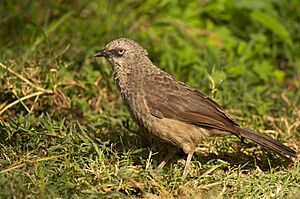Black-lored babbler facts for kids
Quick facts for kids Black-lored babbler |
|
|---|---|
 |
|
| At Lake Naivasha, Kenya | |
| Conservation status | |
| Scientific classification | |
| Genus: |
Turdoides
|
| Species: |
sharpei
|
The black-lored babbler (Turdoides sharpei) is a type of bird that lives in parts of Africa. It is also known as Sharpe's pied-babbler. You can find this bird in southwestern Kenya, Tanzania, Uganda, Burundi, Rwanda, and a small part of the Democratic Republic of the Congo.
This bird belongs to the Leiothrichidae family. It was once thought to be the same species as the black-faced babbler (Turdoides melanops), which lives in southern Africa.
What Does the Black-lored Babbler Look Like?
These birds are mostly grey-brown. They have white spots, especially on their bellies. The amount of white spotting can be different depending on where the bird lives and each individual bird.
For example, babblers near Nanyuki, Kenya, are darker. They might have a pure white chin or even a completely white throat. Adult black-lored babblers have pale yellow or white eyes. They also have black "lores," which are the areas between their eyes and their beaks. This special combination helps tell them apart from other similar babblers. However, young babblers always have brown eyes.
Where Do Black-lored Babblers Live?
Like other birds in the Turdoides group, the black-lored babbler usually stays low to the ground. They prefer areas with thick bushes and trees. You can often find them in or near dense woody plants. They even live in areas where people grow crops.
In Kenya, these birds look for food in bushes and tall grass. They are known to be quite active and noisy. They are also "gregarious," which means they like to live in groups.
How Do Black-lored Babblers Communicate?
Black-lored babblers make different sounds. A single bird might make a harsh sound like waaach or a muffled kurr-ack. They often repeat these sounds.
When two or more babblers are together, they sing longer songs as a group. Their songs are often slower than what you might expect from other babblers. They are most vocal and noisy in the early morning and late afternoon.


